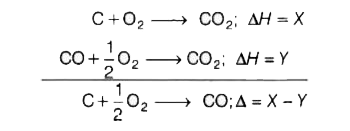यदि C(s)+O2(g)→CO2(g)ΔH=X तथा CO(g)+12O2(g)→CO2(g),ΔH=Y तब CO की सम्भवन ऊष्मा है
X+Y
X-Y
Y-X
XY
The correct Answer is:B
Topper's Solved these Questions
- रासायनिक ऊष्मागतिकीBook:ARIHANT HINDIChapter:रासायनिक ऊष्मागतिकीExercise:प्रश्नावली (विगत वर्षो के प्रश्न )
Explore 20 Videos
- रासायनिक आबन्ध तथा आणविक संरचना Book:ARIHANT HINDIChapter:रासायनिक आबन्ध तथा आणविक संरचना Exercise:परीक्षा की तैयारी हेतु प्रश्नावली (विगत वर्षों के प्रश्न)
Explore 19 Videos
- रासायनिक बलगतिकी Book:ARIHANT HINDIChapter:रासायनिक बलगतिकी Exercise:विगत वर्षों के प्रश्न
Explore 18 Videos
Similar Questions
निम्नलिखित व्यंजकों में से कौन-सा असत्य है?
View Solutionन्यूनतम आबन्ध कोण वाला अणु है
View Solutionकिसी रासायनिक अभिक्रिया का वेग ताप में प्रत्येक 10∘C ताप वृद्धि के कारण दोगुना हो जाता है। यदि ताप में 50∘C की वृद्धि की जाये तो अभिक्रिया का वेग लगभग बढ़ेगा
View SolutionIf C(s)+O_(2)(g)rarrCO_(2)(g),DeltaH=X and CO(g)+1//2O_(2)(g)rarrCO_(2)(g),DeltaH=Y , then the heat of formation of CO is
View SolutionC(s)+O2(g)→CO2(g), ΔH=−94.3kcal/mol
CO(g)+12O2(g)→CO2(g), ΔH=−67.4kcal/mol
O2(g)→2O(g), ΔH=117.4kcal/mol
CO(g)→C(g)+O(g), ΔH=230.6kcal/mol
Calculate ΔH for C(s)→C(g) in kcal/mol
View SolutionConsider the following reactions:
C(s)+O2(g)→CO2(g)+x kJ
CO(g)+12O2(g)→CO2(g)+y kJ
The heat formation of CO(g) is :
View SolutionThe following reaction are given : CH_(4(g))+2O_(2(g))toCO_(2(g))+2H_(2)O(g),DeltaH=-x C_((s))+O_(2(g))toCO_(2(g)),2H_(2(g)),DeltaH=-y H_(2(g))+(1)/(2)O_(2(g))toH_(2)O_((g)),2H_(2(g)),DeltaH=-z calculate the heat of formation of CH_(4) ?
View SolutionCalculate the ΔH in joules for
C(graphite)→C(diamond)
from the following data:
C(graphite)+O2(g)→CO2(g): ΔH∘=−393.5kJ
C(diamond)+O2(g)→CO2(g), ΔH∘=−395.4kJ
View Solutionनिम्नलिखित आँकड़ों के आधार पर अभिक्रिया C(s)+O2(g)→CO2(g) के लिए q और ΔH की गणना करें।
(i) C(s)+12O2(g)→CO(g)+26kcal
(ii) CO(g)+12O2(g)→CO2(g)+68kcal
View Solutionनिम्नलिखित ऑकड़ों के आधार पर कार्बन मोनोक्साइड (CO) के गठन की ऊष्मा (या एन्थैल्पी) ज्ञात करें।
(i) C(s)+O2(g)→CO2(g):ΔH=−393.3kJmol−1
(ii) CO(g)+12O2(g)→CO2(g),ΔH=−282.8kJmol−1
View SolutionConsider the reaction, C(s)+O_(2)(g)toCO_(2)(g)+393.5kJ , the signs of DeltaH,DeltaS and DeltaG respectively are
View SolutionC(s)+O_(2)(g)toCO_(2)(g),DeltaH=-94 kcal 2CO(g)+O_(2)to2CO_(2),DeltaH=-135.2 kcal The heat of formation of CO(g) is
View SolutionOn the basis of following thermochemical equations H_(2)O(g)+C(s)toCO(g)+H_(2)(g),DeltaH=131kJ CO(g)+(1)/(2)O_(2)(g)toCO_(2)(g),DeltaH-282kJ H_(2)(g)+(1)/(2)O_(2)(g)toH_(2)O(g),DeltaH=-242kJ C(s)+O_(2)(g)toCO_(2)(g),DeltaH= X kJ:- The value of X will be
View SolutionWhy are the standard reaction enthalpies of the following two reactions different? (1) C(graphite, s) +O_(2)(g)toCO_(2)(g),DeltaH^(0)=-393.5kJ (2) C(diamond, s) +O_(2)(g)toCO_(2)(g),DeltaH^(0)=-395.4kJ
View SolutionGiven: C(s)+O_(2)(g)toCO_(2)(g),DeltaH=-393.5kJ 2H_(2)(g)+O_(2)(g)to2H_(2)O(g),DeltaH=-571.6kJ Calculate DeltaH of the reaction: C(s)+2H_(2)O(g)toCO_(2)(g)+2H_(2)(g) .
View Solution

